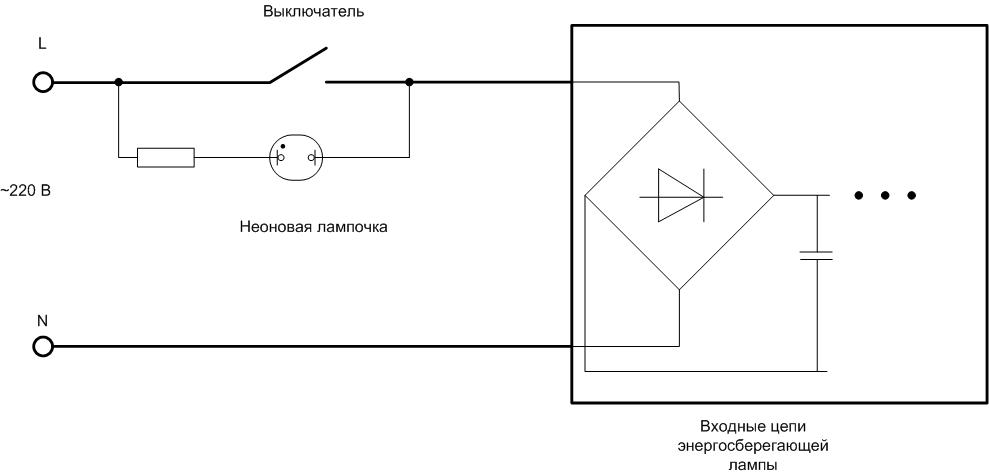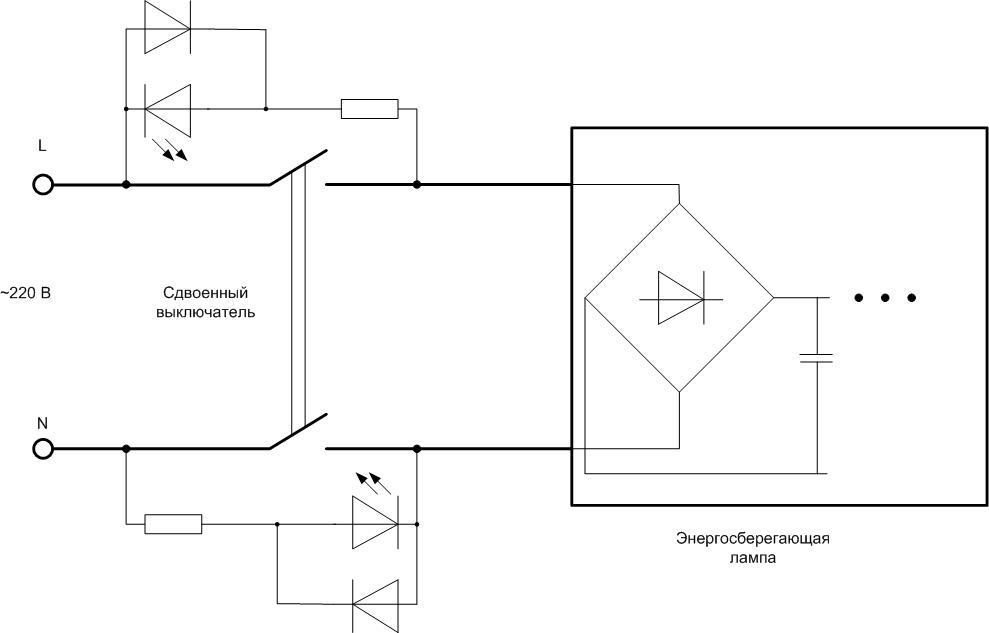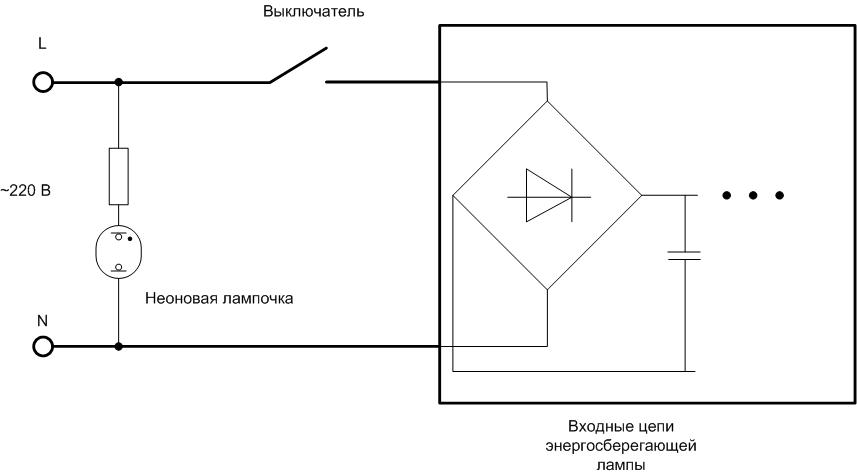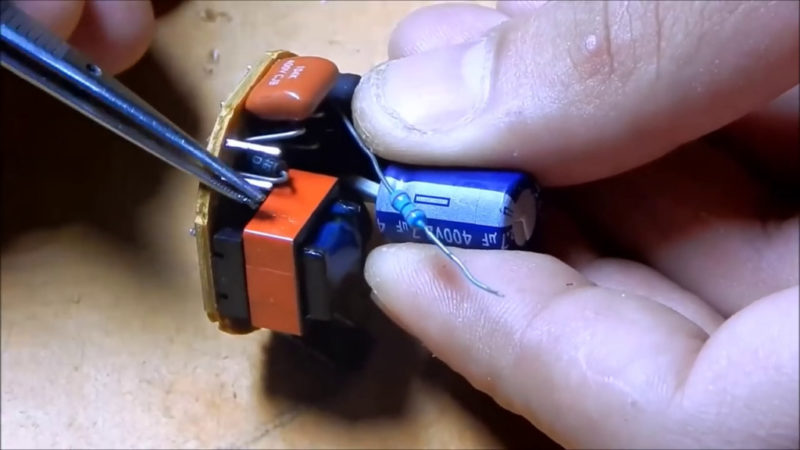Why an energy-saving bulb flashes when the light is off
Energy-saving lamps have some success in the market of lighting equipment. Although it is believed that they have lost competition with LED equipment (mainly due to the expensive disposal), the demand for such fixtures is still big. But some users have encountered an annoying phenomenon - the energy-saving lamp flashes even when the light is off. To eliminate this problem, it is necessary to find out its causes.
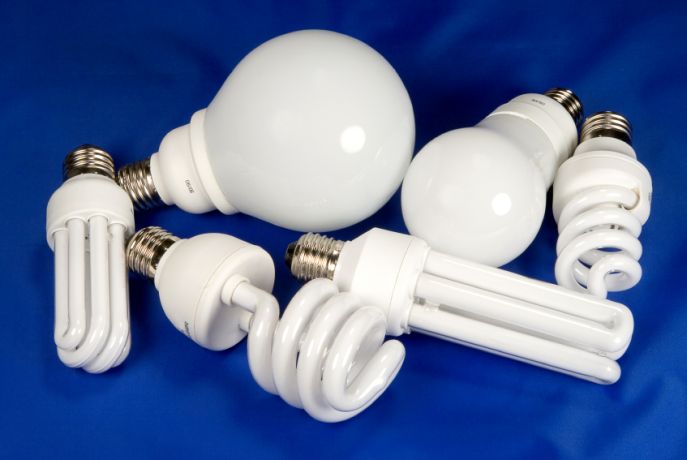
Backlighting on a light switch
Lighted switch looks aesthetically pleasing and creates additional convenience - when the light is off, it is easier to find. The illuminating chain is based on a neon lamp or LED and creates a small current through the chandelier even when it is off. In terms of winding up the electric meter, this current is almost imperceptible. Nor can it ignite an incandescent bulb. The power saving lamp also needs more power, but the unpleasant effect still occurs.
It is all about the circuit of such a luminaire. It is powered by rectified voltage of 220 V, and after the rectifier a smoothing capacitor is installed. A capacitor has the property of storing energy, and then when it reaches a certain threshold, it gives it away at once. At this point there is a momentary glow in the lamp bulb.
To overcome this phenomenon, there are different ways:
- Remove the illuminating circuit. Desolder it or just bite it out. Or replace the switch with a fixture with no extras.
- If the backlight must be left on, you can switch both the phase wire and the common wire when you turn the lamp on and off. Then the circuit for the charging current will be interrupted and the unpleasant blinking will stop. Household device of this type is difficult to buy, and production is unlikely to fit into the interior. Therefore, you can take a two-button switch, connect it in the gap of each wire, and instead of two keys to install one, taking it from the device of the same manufacturer. If this is not possible, the keys can be inconspicuously connected mechanically.
- It is also possible to reconnect the illuminating circuit so that it is permanently connected to the mains. In this case it will not go out when the lights are on, but this disadvantage is unlikely to annoy anyone. Although the power consumption will increase, it will remain at the same microscopic level.
- There are situations where the energy-saving element is used in parallel with other bulbs (for example, in a spot lighting system). In this case, you can replace one of the bulbs with an incandescent bulb. It will shunt the other elements with the cold filament, the current will go through it, and the charge will not accumulate in the input capacitors.
- Include a resistor in parallel to the lamp, with a resistance of about 50 kohms and a power of 2 or more watts. In this case also one additional element per group of lamps is enough. The parasitic current will go mostly through this resistor.
Wiring error
It happens that the energy-saving lamp flashes even after it is turned off due to improper installation, when the switch breaks the neutral and not the phase wire. In this situation, the lamp remains energized, and the current sufficient to periodically charge the capacitor is created by leaks. They may arise for two reasons:
- Because of old insulation that is losing its operational properties;
- because of the presence of capacitive current.
Important! This situation requires immediate correction also for safety reasons. If the zero is broken, the lamp will not glow, creating the illusion of no voltage. This can lead to electrocution during repair work.
To correct the problem, redo the wiring at the nearest convenient location (on the terminal block or in the junction box), but before the switching element. It is necessary to swap the phase and neutral wires.
We recommend that you watch this:
A sign of professionalism is the use of cables with different colors of wire insulation and compliance with color standards:
- Blue wire is for neutral wire;
- brown - phase wire;
- if there is a grounding conductor, yellow-green is used for it.
If the electrician has developed the habit of strictly following the rules, the probability of mistakes during installation is greatly reduced.
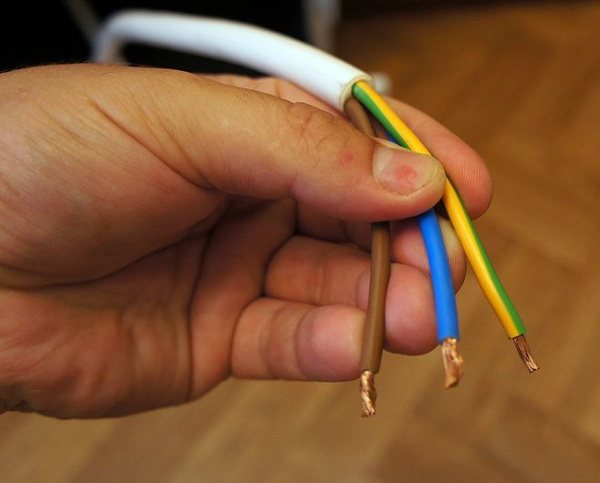
But the parasitic capacitance is not eliminated in this way, and in some cases flashes can continue because the voltage of the neutral wire relative to ground is almost never zero. It can be a few volts or even a dozen or so volts. Through capacitive coupling, a current will be created in the circuit, which can be stored by the input capacitor and create flashes. To eliminate this effect, you can try the measures from the previous point: break both circuits or shunt the lights with an incandescent lamp (resistor).
Poor quality bulb
Often the lamp fails and starts flashing simply because of the use of poor-quality materials for wire insulation, cheap consumables for soldering circuit components (flux, etc.), violation of production technology (not careful washing of boards, etc.). All this leads to unpredictable results in operation, including the occurrence of leaks. Therefore, you should buy lamps from reputable manufacturers, although they are somewhat more expensive. A variant of the rating of manufacturers of energy-saving lighting fixtures is given in the table:
| Place | 1 | 2 | 3 | 4 | 5 |
| Manufacturer | Philips | LIGHTSTAR | UNIEL | OSRAM | Camelion |
| Country | Netherlands | Italy | China | Germany | Hong Kong |
You should also pay attention to the Russian brand Era.
It should be taken into account that when disassembling failed lamps you will often find traces of condensation accumulation. Most luminaires have a leaky design, which over time leads to mass failure of lamps operated in conditions of high humidity. This can also cause current leaks inside the control circuitry of the energy-saving lamp.
Important! This method does not require additional costs, it only requires the presence of a spare lighting element. In order to save time and money for troubleshooting, a trial replacement of the lamp is recommended to do in the first place. Further diagnostics should be carried out in case of failure.
Preventive measures
Whatever the cause of the flashing lamp, this phenomenon does not only cause a feeling of discomfort. The problem is also that so quickly the resource of the lamp is exhausted. It is used up in a few months, after that you have to buy a new lamp again and it is not cheap.
Any problem is easier to prevent than to correct. Therefore, the following preventive measures are suggested to reduce the likelihood of the flashing effect when the voltage is removed:
- Purchase only high-quality energy savers from reputable manufacturers.
- If you perform the installation yourself, follow the correct wiring diagrams. If an outside specialist is hired for the work, supervise his work.
- Keep an eye on the condition of the electric wiring.
- Use only sealed lamps in wet areas.
The time of existence of energy-saving lamps on the market seems to be coming to an end. They have lost competition to LED lights in all respects and incandescent bulbs in price and environmental friendliness. But the energy-saving bulbs that are still in use can still serve their owners. They only need to be properly operated.
